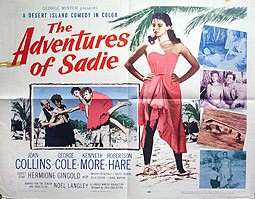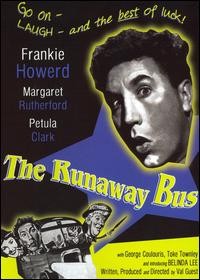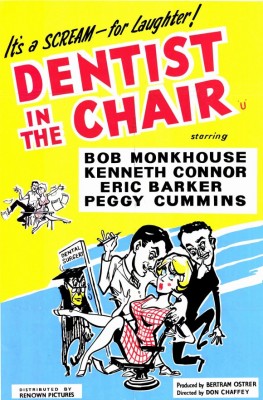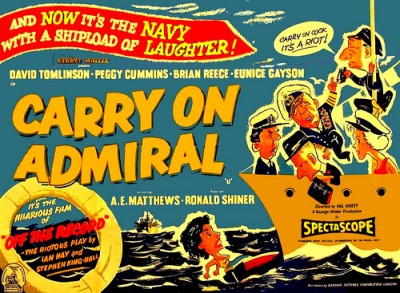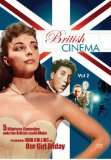| Reviews & Columns |
|
Reviews DVD TV on DVD Blu-ray 4K UHD International DVDs In Theaters Reviews by Studio Video Games Features Collector Series DVDs Easter Egg Database Interviews DVD Talk Radio Feature Articles Columns Anime Talk DVD Savant Horror DVDs The M.O.D. Squad Art House HD Talk Silent DVD
|
DVD Talk Forum |
|
|
| Resources |
|
DVD Price Search Customer Service #'s RCE Info Links |
|
Columns
|
|
|
British Cinema Vol 2 (Our Girl Friday / Dentist in the Chair / The Runaway Bus / Carry on Admiral / The Time of His Life)
Fans of British comedy will delight in the diversely talented casts, featuring Joan Collins, Kenneth More, Bob Monkhouse, Kenneth Connor, Frankie Howerd, Margaret Rutherford, Petula Clark, David Tomlinson, Joan Sims, and Richard Wattis, among many others. The transfers are, frankly, subpar though the better films in the set tend to suffer less than the weaker ones do. This two-disc collection is region-free.
Released in America as The Adventures of Sadie (see above), Our Girl Friday is billed in the packaging as if it were VCI's headliner, but in fact it's the feeblest film in the bunch, with the least-pleasing transfer. It was, however, filmed in color, on the Isle of Mallorca, in Spain, and stars Joan Collins, about the only star widely known to present-day American audiences.
Sadie Patch (Collins) is a lonely, spoiled heiress (her father owns a bottle opener empire) and during an ocean voyage her ship collides with a freighter and she ends up stranded on a small, uncharted South Seas island - all of the other passengers and crew apparently were rescued. Three others have likewise made it safely to shore: hard-drinking Irish stoker Pat Plunkett (Kenneth More), cynical journalist Jimmy Carrol (George Cole), and stuffy academic Professor Gibble (Robertson "Bunny" Hare). (The film may have been partly inspired by Fox's big film of Titanic, released earlier that same year; More, of course, would star in the best film about the doomed ocean liner, A Night to Remember, a few years later.)
Exactly what you'd expect given the situation follows, albeit at a snail's pace. The men make a pact not to pursue her, though Jimmy and Professor Gibble quickly succumb to her charm, or something. She's snooty throughout and they're no better while Pat, an insufferable stereotyped Irishman (all that's missing are muttonchops and a clay pipe), plays the men one off the other, like Toshiro Mifune with the warring gangsters in Yojimbo (1961). None of the characters are remotely likeable, and the film is a total misfire, with even fewer laughs than the similarly-styled Atoll K (1951), Laurel & Hardy's disastrous final film, which at least had a chuckle or two.
Borrowed from the J. Arthur Rank Organisation, Joan Collins was Hot Stuff in 1953 when this was made, and the following year was signed by 20th Century-Fox in America in an attempt to rival to MGM's Elizabeth Taylor. In Our Girl Friday, Collins's Sadie fashions a bikini out of Pat's sailor shirt, and the then 20-year-old actress is undeniably sexy traipsing around the island in it. Bikinis were in 1953 still quite scandalous; the modern swimwear was introduced in France in 1946 but didn't catch on for quite some time in Britain and America; when Our Girl Friday was released American women wouldn't have been caught dead in one.
The film has an excellent cast, but no one is used well, especially the wonderful More. Also in the cast are Hermione Gingold, Hattie Jacques, and Felix Felton. Peter Sellers reportedly does the voice of at least one parrot, though his work is uncredited.
Directed by Val Guest, The Runaway Bus is a real gem, worth the cost of the set for it alone. It's not only the kind of thing the British do best - confine a limited number of characters engaged in a relatively simple problem and explore their varied eccentricities - but the film also unexpectedly works as a light-hearted mystery featuring much imaginative noir-like cinematography, a low-budget British equivalent to John Alton's Eagle-Lion noirs from a few years before. (Reportedly all the fog and shadows was to hide the meager budget, but the film's cheapness never gets in the way of the fun.)
The film was comedian Frankie Howerd's official screen debut; he plays Percy Lamb, an inept bus driver shuttling passengers from Heathrow to Blackbushe Airports when their flights are diverted due to thick fog. B.O.A.C. air hostess Lee Nichols (Petula Clark, very young) accompanies him, and they are joined by eccentric biddy Cynthia Beston (Margaret Rutherford), milquetoast Henry Waterman (Toke Townley), B.O.A.C. pilot Peter Jones (Terence Alexander, who passed away just a few days ago), ditzy pulp horror-suspense addict Janie Grey (Belinda Lee), and surly businessman Shroeder (Citizen Kane and The Man without a Body's George Coulouris).
Meanwhile, authorities investigating the robbery of £200,000 in gold bullion determine it's been stashed in the boot of Percy's bus, and that the thief or thieves are on board, masquerading as passengers.
The Runaway Bus is a delight. It has the uncluttered simplicity of Laurel and Hardy and the genre fusing of an Abbott & Costello, yet the humor is resolutely British, Howerd's Percy being a prime example. Part of the new wave of outrageously gay comic personae to emerge - 90% anyway* - out of the closet during the early postwar period Howerd, like Kenneth Williams and Charles Hawtrey, expanded on the coded "queer" character types found in earlier Hollywood films, fussily played by actors like Franklin Pangborn and Edward Everett Horton. Howerd's specialty was seemingly off-the-cuff expressions of mock-outrage, often sardonic, risqué asides expressed in supposed innocence. Though a somewhat limited characterization, in that role no one was funnier.
In The Runaway Bus Howerd gets to play off a great supporting cast; his eye-rolling reactions to Margaret Rutherford's typically peculiar behavior are quite hilarious, while she's in peak form here. Though best remembered by American audiences for her film roles as Miss Marple, Rutherford was best when cut loose and allowed to play the full-on eccentric, which she apparently was in real-life as well. The rest of the cast is just fine, the usual assortment of actors one regularly finds in this sort of thing. Michael Gwynn, Marianne Stone, and Sam Kydd are among those in small but memorable roles.
Cinematographer Stanley Pavey spent most of his career photographing similar films, though he did shoot Dead of Night (1945) early in his career. In any case, the film's sustained noir look and Val Guest's script are as impressive as the best performances. Reportedly Howerd requested that the film work as a straight mystery in case audiences didn't take to him or his character. Impressively, the film keeps the viewer guessing until the final minutes, and the dénouement is actually a surprise.
Val Guest also had a hand in Dentist in the Chair, which he co-scripted (after Matthew Finch's novel), though busy genre director Don Chaffey was at the helm. The film was an obvious attempt to cash in on two popular comedy series: the "Doctor" films with Dirk Bogarde and the newly-successful "Carry On" comedies, in which co-stars Bob Monkhouse (who rewrote much of his dialogue in this) and Kenneth Connor had already appeared.
The film is set at a dental college, where students David Cookson (Monkhouse), Brian Dexter (Ronnie Stevens), and David's girlfriend, Peggy (Peggy Cummins, of Gun Crazy and Night of the Demon fame) become the unwitting receivers of stolen merchandise, dental instruments stolen by inept burglar Sam Field (Connor). After initially selling the instruments to fellow students at bargain prices, they must replace everything once they realize it's hot merchandise before the coppers catch up with them, or they're found out by The Dean (Eric Barker, amusingly oblivious to everything around him).
It's a meager premise on which to build an 84-minute comedy (the version presented here is cut; see below), but the cast is enjoyable, if a bit old to make believable dental students. Besides Barker, Connor comes off best as the clichéd uncultured Cockney crook. It's a very broad characterization but Connor's funny and likeable as are his resistant partners in crime: Monkhouse, Stevens, and the appealing Cummins.
A sequel with Monkhouse, Stevens, and Connor, Dentist On the Job, is available as a Region 2 DVD.
American viewers unfamiliar with the comic actor Richard Hearne will likely find The Time of His Life a real head-scratcher; it's so mild and slight as to be almost invisible. Hearne (1908-1979) was a star of early British television, famous for an apparently Tati-esque (or maybe Bean-esque) character he created named Mr. Pastry, a persona that had been dominating his career since originating the character in a 1936 stage show. Pastry was a bumbling old man with a trademark bowler hat and walrus mustache, and the comedy Hearne engaged in was primarily slapstick. (Hearne later became additionally famous for almost playing Doctor Who following Jon Pertwee, a role he reportedly lost because he insisted on playing The Doctor as Mr. Pastry.)
However, though The Time of His Life was intended as a showcase for Hearne's characterization, apparently it was heavily altered for the film, in which the movie Pastry becomes a wrongly-convicted prisoner who served years for an embezzlement he didn't commit. He's released to the custody of his nasty socialite daughter (Ellen Pollack, an actress actually older than Hearne, and boy does she look it), who promptly locks her old man up in the attic, a veritable prisoner, hoping to keep him out of sight, out of mind.
Whatever Hearne's charms in other films and venues, in The Time of His Life he comes off as a rather undistinguished character player not particularly funny, just a pathetic milquetoast type. The picture has a slight edge over Our Girl Friday only because of its slight strangeness; it's almost a comedy about adult children being psychologically abusive to a kindly parent they're ashamed of. Further adding to the strangeness is the film's innocuous musical score, performed on a pipe organ and sounding exactly like the kind of thing one used to hear at the local roller rink or ballgame. Very odd.
Carry on Admiral, also adapted (from an Ian Hay stage play) and directed by Val Guest, is not related to the subsequent "Carry On" comedies soon to follow, though somewhat similar stylistically, and "Carry On" regular Joan Sims has a supporting part as a hotel maid.
It's a fairly strained farce about a junior parliamentary official, Tom Baker (Mary Poppins' David Tomlinson) and an old friend, Royal Navy officer Peter Fraser (Brian Reece) who are coincidentally reunited the night before Fraser is to take up his first command. The pair get drunk and switch clothes, and the next morning each is mistaken for the other, and rather than come clean allow the deception to continue well past the point of no return.
Peggy Cummins is back, joined by gorgeous Eunice Gayson, best remembered today as James Bond's first girlfriend, in both Dr. No (1962) and From Russia with Love. Back in 1957 however, Gayson was a real knockout (as opposed to merely conventionally glamorous, as she was in the Bond films), a kind of British Faith Domergue. As with the other entries it's fun to see familiar character actors and comedians like Sims, Ronald Shiner, Peter Coke, Joan Hickson, Reginald Beckwith, and A.E. Matthews - even in a film as mild as this. However, more than the others Carry on Admiral is compromised by a poor transfer. The film, released in America as The Ship was Loaded, was photographed in SpectraScope, a 2.35:1 anamorphic process akin to CinemaScope. The opening credits are 4:3 letterboxed, but after that the presentation is full-frame panned-and-scanned, with a slight squeeze added to the picture, but not enough of a squeeze to call it 16:9 enhancement. The resultant image is soft and awkwardly framed throughout.
Video & Audio
The good news is that the best film of the bunch, The Runaway Bus doesn't suffer too terribly from its less-than stellar transfer, but everything here is definitely sub-par. Our Girl Friday looks like a very old transfer of inferior elements, a transfer not much better than a PD release. There's terrible ghosting, scratches, tepid color, and the film element sourced is even warped at one point, pulsating in and out of focus. Our Girl Friday includes a Spanish audio track.
The Time of His Life and Dentist in the Chair should be 16:9 enhanced widescreen at 1.66:1 but instead are 4:3 full frame sourced from splice-filled prints. The cropping of Carry on Admiral is discussed above. Two of the films are also short: Dentist in the Chair has a listed running time of 84 minutes but here runs 75; Carry on Admiral is supposed to be 83 minutes but runs 78.
The only Extra Features are a batch of unrelated trailers and a photo gallery for Our Girl Friday.
Parting Thoughts
British Cinema Vol 2 is Recommended, if only for the funny and charming The Runaway Bus and for the curiosity factor with the other titles - but the mediocre transfers vaporize much initial enthusiasm.
* Though homosexuality was technically illegal in Britain until 1967, few doubted Howerd's sexual orientation, any more than they did Williams's or Hawtrey's.
Film historian Stuart Galbraith IV's latest book, Japanese Cinema, is on sale now.
|
| Popular Reviews |
| Sponsored Links |
|
|
| Sponsored Links |
|
|
| Release List | Reviews | Shop | Newsletter | Forum | DVD Giveaways | Blu-Ray | Advertise |
|
Copyright 2024 DVDTalk.com All Rights Reserved. Legal Info, Privacy Policy, Terms of Use,
Manage Preferences,
Your Privacy Choices | |||||||









